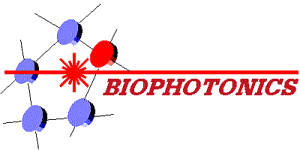
D.Frolov,R.Purlys*, S.Bagdonas, R.Rotomskis, M.Gavutis
Laser Research Centre, Vilnius University, Sauletekio 9, 2040 Vilnius
Lithuania
*Physics Faculty, Vilnius University, Sauletekio 9, 2040 Vilnius, Lithuania
 |
D.Frolov,R.Purlys*, S.Bagdonas, R.Rotomskis, M.Gavutis
|
|
| Results and Discusion As it was shown below in the spectroscopic part of this presentation TPPS4 in acidic solutions forms J-aggregates. Also there was shown, that molecules in J-aggregate are connected through negatively charged sulphonato- group and positively charged center of the porphyrin ring. X-ray diffraction is a commonly used method for studying the structure of various substances with the periodic structure. Therefore it was applied to study the spatial structure of J-aggregates, in particular, for the determination of distances between the reflecting planes in J-aggregate. The dependence of X ray intensity on the diffraction angle was measured. The X-ray diffraction spectrum consisted of the 17 diffraction peaks, from which characteristic distances in the J-aggregate were calculated (Tab.1). Tab.1 Characteristic distances in TPPS4 J-aggregate spatial structure. A part of them were attributed to the distances in TPPS4 macrocycle, which were taken form the study of A.Stone et all [2]. The data presented by the authors concern meso-tetraphenylporphin (TPP) instead of TPPS4, however , as sulphonato- groups being attached to phenyl groups in para-positions don't change the inner molecular structure,those data can be applied to the TPPS4 as well. The other distances beeing determined presumably belong to the intermolecular distances in J-aggregate. The analysis of the data implied the presence of two different types of TPPS4 J-aggregates. One of the possible structure of TPPS4 J-aggregates is shown in Fig.6(a). Molecules form a chain where interaction between adjacent molecules is ensured via an electrostatic attraction between negatively charged sulpho group (SO3-) and the central part of positively charged porphyrin macrocycle. Picosecond spectroscopy data also support the linear structure of J-aggregate [3]. Fig.6(a) The suggested spatial structure of TPPS4 J-aggregates However, this model does not explain the origin of some peaks and the corresponding distances. Another model of J-aggregate sugesting a structure of 3 molecules in elemental lattice is also possible. In this model two molecules forming the lattice are located on the parallel planes. The third one is kept in between of those two by the similar electrostatic interaction as in the previous model (Fig.6b). Such structure corresponds to the longest distances between the equivalent planes. However, this model also can not explain the origin of some peaks and the corresponding values of intermolecular distances. Fig.6(b) The suggested spatial structures of TPPS4 J-aggregates The models discussed above are not the only possible, however they explain the experimental data best.
AFM data of J-aggregates on top of the silicon oxide are shown in Fig.7.
Fig.7 TPPS4 J-aggregates on top of silicon oxide.
The image reflecting the changes in height is not very informative. However phase image, because of a better contrast reveals some linear structures present on the surface. These structures were attributed to TPPS4 J-aggregates. This is a good aggreament with X-ray (Fig.6a) and excited state relaxation data [3]. On the other hand there are some stack like structures on the surface (inside circles). This gives an idea that macroaggregates of several paralel J-aggregates are possibly formed. If this is true, then longer distances in X ray difraction data could also be explaned by distances characteristic for new formed macroaggregates. |
![]()
![]()
|
|
![]()